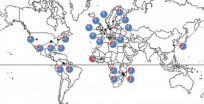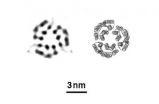(Press-News.org) It's much easier to remember a place you have visited than a long, complicated password, which is why computer scientist Ziyad Al-Salloum of ZSS-Research in Ras Al Khaimah, UAE, is developing a system he calls geographical passwords.
Writing in a freely available "open access" research paper in the International Journal of Security and Networks, Al-Salloum emphasizes how increasingly complicated our online lives are becoming with more and more accounts requiring more and more passwords. Moreover, he adds that even strong, but conventional passwords are a security risk in the face of increasingly sophisticated "hacker" tools that can break into servers and apply brute force to reveal passwords. Indeed, over the last few years numerous major corporations and organizations - LinkedIn, Sony, the US government, Evernote, Twitter, Yahoo and many others - have had their systems compromised to different degrees and overall millions of usernames and associated passwords have been harvested and even leaked online.
Al-Salloum has devised geographical passwords as a simple yet practical approach to access credentials that could provide secure access to different entities and at the same time mitigate many of the vulnerabilities associated with current password-based schemes. The new "geo" approach exploits our remarkable ability to recall with relative ease a favorite or visited place and to use that place's specific location as the access credentials. The prototype system developed at ZSS – Research has proven itself capable of protecting a system against known password threats. "Proposing an effective replacement of conventional passwords could reduce 76% of data breaches, based on an analysis of more than 47,000 reported security incidents," Al-Salloum reports.
The geographical password system utilizes the geographical information derived from a specific memorable location around which the user has logged a drawn boundary- longitude, latitude, altitude, area of the boundary, its perimeter, sides, angles, radius and other features form the geographical password. For instance, the user might draw a six-side polygon around a geographical feature such as the Eiffel Tower, Uluru (also known as Ayer's Rock), a particular promontory on the Grand Canyon, a local church, a particular tree in the woodland where they walk their dog…or any other geographical feature. Once created, the password is then "salted" by adding a string of hidden random characters that are user-specific and the geographical password and the salt "hashed" together. Thus, even if two users pick the same place as their geographical password the behind-the-scenes password settings is unique to them.
If the system disallowed two users from picking the same location, this will make it much easier for adversaries to guess passwords.
The guessability, or entropy, of a geographical password would increase significantly if the password comprised two or more pinpointed locations. Al-Salloum explains that a whole-earth map might have 360 billion tiles at 20 degrees of "zoom", which offers an essentially limitless number of essentially unguessable geographical passwords.
INFORMATION:
"GeoGraphical passwords" in Int. J. Security and Networks, 2014, 9, 56-62
A PDF of the peer-reviewed research paper is available via Open Access to everyone here:
https://www.inderscience.com/admin/ospeers/getSource.php?id=64160&fid=1148952&fromonsusy=yes
Geographical passwords worth their salt
Protect yourself online with your secret place
2014-02-14
ELSE PRESS RELEASES FROM THIS DATE:
Antimicrobial preservation strategies to prevent food contamination
2014-02-14
New Rochelle, NY, February 13, 2014—Food spoiling and poisoning caused by microbial contamination can cause major health, social, and economic problems. The broad scope of antimicrobial approaches to kill or prevent the growth of microorganisms in foods and beverages, including a variety of natural and artificial preservative strategies, are described in a comprehensive Review article in Industrial Biotechnology, a peer-reviewed journal from Mary Ann Liebert, Inc., publishers. The article is available on the Industrial Biotechnology website.
In the Review "Ingredient ...
New depression treatments reported
2014-02-14
MAYWOOD, IL – New insights into the physiological causes of depression are leading to treatments beyond common antidepressants such as Prozac and Zoloft, researchers are reporting in the in the journal Current Psychiatry.
Depression treatments on the horizon include new medications, electrical and magnetic stimulation of the brain and long-term cognitive behavioral therapy for stress management.
Authors are Murali Rao, MD, and Julie M. Alderson, DO. Rao is professor and chair of the Department of Psychiatry and Behavioral Neurosciences at Loyola University Chicago ...
Geographic variation of human gut microbes tied to obesity
2014-02-14
People living in cold, northern latitudes have bacteria in their guts that may predispose them to obesity, according to a new study by researchers at the University of California, Berkeley, and the University of Arizona, Tucson.
The researchers' analysis of the gut microbes of more than a thousand people from around the world showed that those living in northern latitudes had more gut bacteria that have been linked to obesity than did people living farther south.
The meta-analysis of six earlier studies by UC Berkeley graduate student Taichi Suzuki and evolutionary ...
What do women want? It depends on the time of the month
2014-02-14
If she loves you and then she loves you not, don't blame the petals of that daisy. Blame evolution.
UCLA researchers analyzed dozens of published and unpublished studies on how women's preferences for mates change throughout the menstrual cycle. Their findings suggest that ovulating women have evolved to prefer mates who display sexy traits – such as a masculine body type and facial features, dominant behavior and certain scents – but not traits typically desired in long-term mates.
So, desires for those masculine characteristics, which are thought to have been ...
Another reason to not mix work and family: Money makes parenting less meaningful
2014-02-14
Austin – February 14, 2014 - Money and parenting don't mix. That's according to new research that suggests that merely thinking about money diminishes the meaning people derive from parenting. The study is one among a growing number that identifies when, why, and how parenthood is associated with happiness or misery.
"The relationship between parenthood and well-being is not one and the same for all parents," says Kostadin Kushlev of the University of British Columbia. While this may seems like an obvious claim, social scientists until now have yet to identify the psychological ...
In-hospital formula use deters breastfeeding
2014-02-14
(SACRAMENTO, Calif.) — When mothers feed their newborns formula in the hospital, they are less likely to fully breastfeed their babies in the second month of life and more likely to quit breastfeeding early, even if they had hoped to breastfeed longer, UC Davis researchers have found.
"We are a step closer to showing that giving formula in the hospital can cause problems by reducing how much women breastfeed later," says Caroline Chantry, lead author and professor of clinical pediatrics at UC Davis Medical Center. "Despite being highly motivated to breastfeed their babies, ...
Superbright and fast X-rays image single layer of proteins
2014-02-14
RICHLAND, Wash. -- In biology, a protein's shape is key to understanding how it causes disease or toxicity. Researchers who use X-rays to takes snapshots of proteins need a billion copies of the same protein stacked and packed into a neat crystal. Now, scientists using exceptionally bright and fast X-rays can take a picture that rivals conventional methods with a sheet of proteins just one protein molecule thick.
Using a type of laser known as XFEL, the technique opens the door to learning the structural details of almost 25 percent of known proteins, many of which have ...
Head, neck injuries may increase stroke risk among trauma patients younger than 50
2014-02-14
Suffering an injury to the head or neck increases ischemic stroke risk three-fold among trauma patients younger than 50, according to research presented at the American Stroke Association's International Stroke Conference 2014.
"These findings are important because strokes after trauma might be preventable," said Christine Fox, M.D., M.A.S., lead author and assistant professor of neurology at the University of California San Francisco.
Researchers studied the health records of 1.3 million patients younger than 50 years who had been treated in emergency trauma rooms. ...
Hispanic stroke patients less likely to receive clot-busting drugs in
2014-02-14
Hispanic stroke patients admitted to hospitals in the border states of California, Arizona, New Mexico and Texas were less likely than non-Hispanics in the same border states to receive clot-busting drugs and more likely to die, according to research presented at the American Stroke Association's International Stroke Conference 2014.
Researchers analyzed stroke care for Hispanic and non-Hispanic patients according to demographics and clinical characteristics in states bordering Mexico and states not on the Mexican border. They found:
Of the nearly 35,000 Hispanic stroke ...
Stroke survivors often return to driving without being evaluated for ability
2014-02-14
Stroke survivors often resume driving without being formally evaluated for ability — though stroke can cause deficits that can impair driving, according to research presented at the American Stroke Association's International Stroke Conference 2014.
Researchers surveyed 162 stroke survivors a year after their strokes and found:
More than 51 percent returned to driving — many a month after suffering a stroke.
Only 5.6 percent received a formal driving evaluation.
Eleven percent of those who returned to driving reported their strokes had greatly impacted their abilities ...
LAST 30 PRESS RELEASES:
Shingles vaccine linked to slower biological aging in older adults
A self-assembling shortcut to better organic solar cells
A two-week leap in breeding: Antarctic penguins’ striking climate adaptation
Climate risks to insurance and reinsurance of global supply chains
58% of patients affected by 2022 mpox outbreak report lasting physical symptoms
Golden Gate method enables rapid, fully-synthetic engineering of therapeutically relevant bacteriophages
Polar weather on Jupiter and Saturn hints at the planets’ interior details
Socio-environmental movements: key global guardians of biodiversity amid rising violence
Global warming and CO2 emissions 56 million years ago resulted in massive forest fires and soil erosion
Hidden order in quantum chaos: the pseudogap
Exploring why adapting to the environment is more difficult as people age
Society for Laboratory Automation and Screening welcomes new scientific director: Madeline M. Farley, Ph.D.
Austrian cow shows first case of flexible, multi-purpose tool use in cattle
Human nasal passages defend against the common cold and help determine how sick we get
Research alert: Spreading drug costs over the year may ease financial burden for Medicare cancer patients
Hospital partnership improves follow up scans, decreases long term risk after aortic repair
Layered hydrogen silicane for safe, lightweight, and energy-efficient hydrogen carrier
Observing positronium beam as a quantum matter wave for the first time
IEEE study investigates the effects of pointing error on quantum key distribution systems
Analyzing submerged fault structures to predict future earthquakes in Türkiye
Quantum ‘alchemy’ made feasible with excitons
‘Revoice’ device gives stroke patients their voice back
USF-led study: AI helps reveal global surge in floating algae
New method predicts asthma attacks up to five years in advance
Researchers publish first ever structural engineering manual for bamboo
National poll: Less than half of parents say swearing is never OK for kids
Decades of suffering: Long-term mental health outcomes of Kurdish chemical gas attacks
Interactional dynamics of self-assessment and advice in peer reflection on microteaching
When aging affects the young: Revealing the weight of caregiving on teenagers
Can Canada’s health systems handle increased demand during FIFA World Cup?
[Press-News.org] Geographical passwords worth their saltProtect yourself online with your secret place


